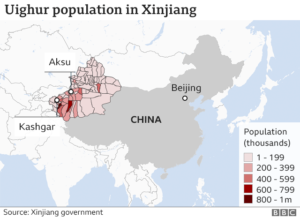In News: China is facing mounting criticism from around the world over its treatment of the mostly Muslim Uighur population in the north-western region of Xinjiang.
About Muslim Uighur
- Uighur, Chinese (Pinyin) Weiwu’er, also spelled Uygur or Uyghur, a Turkic-speaking people of interior Asia.
- Uighurs live for the most part in northwestern China, in the Uygur Autonomous Region of Xinjiang; a small number live in the Central Asian republics.
- There were some 10,000,000 Uighurs in China and at least a combined total of 300,000 in Uzbekistan, Kazakhstan, and Kyrgyzstan in the early 21st century.
- There are about 12 million Uighurs, mostly Muslim, living in north-western China in the region of Xinjiang, officially known as the Xinjiang Uyghur Autonomous Region (XUAR).
- The Uighurs speak their own language, similar to Turkish, and see themselves as culturally and ethnically close to Central Asian nations.
- They make up less than half of the Xinjiang population.
- In recent decades, there’s been a mass migration of Han Chinese (China’s ethnic majority) to Xinjiang, and the Uighurs feel their culture and livelihoods are under threat.

Allegations against China
- The US has accused China of committing genocide against the Uighurs. According to international convention, genocide is the “intent to destroy, in whole or in part, a national, ethnical, racial or religious group”.
- On his final day in office under the Trump administration, US Secretary of state Mike Pompeo said: “I believe this genocide is ongoing, and that we are witnessing the systematic attempt to destroy Uighurs by the Chinese party-state.”
- A UN human rights committee in 2018 said it had credible reports the Chinese were holding up to a million people in “counter-extremism centres” in Xinjiang.
- The Australian Strategic Policy Institute found evidence in 2020 of more than 380 of these “re-education camps” in Xinjiang, an increase of 40% on previous estimates.
















